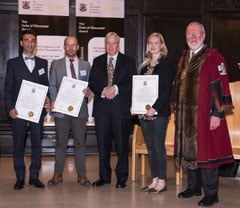Duke of Gloucester Award for excellence in stonemasonry goes to Winchester Cathedral mason Pourang Tajally
The Duke of Gloucester Award for excellence in stonemasonry has this year gone to Pourang Tajally from Winchester Cathedral. Commendations went to Rosie Jones (freelance carver) and three masons from Exeter Cathedral – Anna Steinmetzer, Owen Whitfield, and Matt Hoskins.
This was the fifth annual presentation of the Duke of Gloucester Award and took place at the church of St Stephen Walbrook in London on 13 October. The Award was presented by HRH The Duke of Gloucester himself, proudly sporting his Masons Livery Company tie (he joined the Company in 1975 and became an Honorary Court Member in 1995).
The Awards were launched in 2007, although this year were in a slightly changed format with just one category for masons with between one and 10 years’ experience. The awards are run in conjunction with Stone Federation Great Britain and its Senior Vice President, Dr Tim Yates, was at the presentation ceremony.
The Sheriff and Court Assistant, Dr Christine Rigden (representing the Lord Mayor), and the Masters of several other Livery Companies were able to join the Masons. The Masters came from the Masons' affiliated Livery Companies – The Carpenters, Constructors, Plaisterers, Plumbers & Tylers and Bricklayers. The Chartered Architects and Horners were also represented and the Principals of the Buildings Crafts College in London and City and Guilds of London Art School were also there. That was in addition to more than 50 members of the Masons Company and their guests.
Winner Pourang and Rosie Jones are new Yeomen of the Masons Company and received their membership certificates at the same time as their Duke of Gloucester Award and Certificate (respectively). Another new Yeoman, Will Davies, also received his membership certificate.
The Exeter masons were represented by Chris Sampson, the Cathedral Clerk of Works, who was presented with a Master Craftsman's certificate (another recognition of craft skills from the Masons Company) earlier this year.
The Exeter masons will be presented with their Certificates by the Masons Company Master, William Gloyne, during a service in Exeter Cathedral before the end of the year.
The church of St Stephen Walbrook was a singularly appropriate venue for an event that celebrated excellence in stonemasonry. For many people it is, perhaps, the very best of Christopher Wren's churches, one of the 51 in London that Wren was in charge of rebuilding following the Great Fire of 1666.
It has a special resonance for the Masons' Livery Company as Wren's Master Mason here, as originally at St Paul's, was Thomas Strong senior, who worked closely with Christopher Kempster, Master of the Masons Company in 1691. Thomas Strong also carved the stone font in the church in 1679. His younger brother and the son of his younger brother (both named Edward) became Masters of the Masons Livery Company in 1696 and 1718, respectively. The younger Edward built the tower of the church in 1713-15.
The building was seriously damaged in the blitz of 1941 but rebuilt to the original design in the early 1950s. But that was not the end of the catastrophes to hit the church, as subsidence damage started to become apparent in the 1970s, apparently caused by the Walbrook stream having been diverted underneath the church as a result of surrounding building works. An extensive remedial programme was undertaken between 1978 and 1987, largely led by Lord Palumbo.
During that work, which included the replacement of the mosaic floor with a steel and concrete structure paved with stone, the 10tonne travertine marble altar carved by Henry Moore was installed.
The restoration was controversial but then so was Wren's original design.

